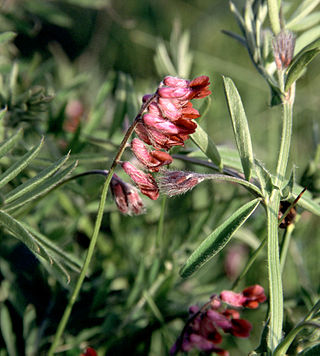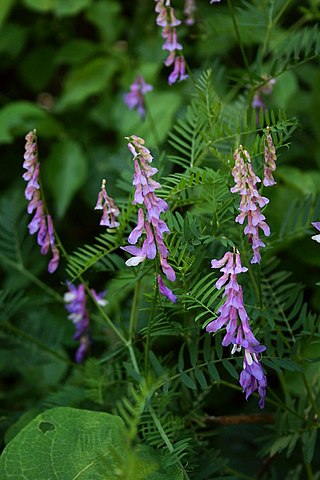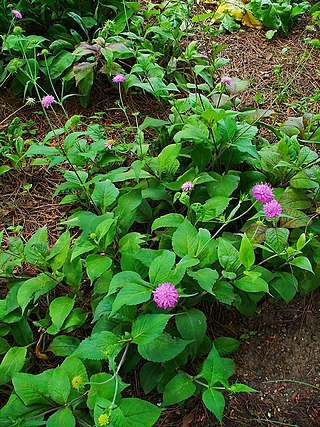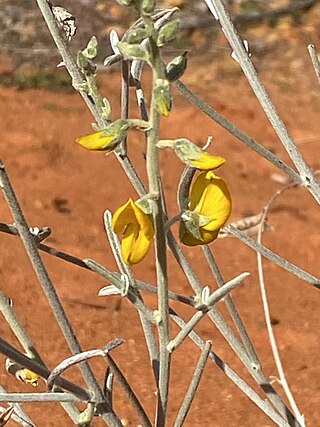
Vicia sativa, known as the common vetch, garden vetch, tare or simply vetch, is a nitrogen-fixing leguminous plant in the family Fabaceae. It is now naturalised throughout the world occurring on every continent, except Antarctica and the Arctic. The centre of diversity is thought to be the Fertile Crescent, although gold standard molecular confirmation is currently not available.

Chamaecytisus is a genus of flowering plants in the legume family, Fabaceae. It includes 43 species which range from the Canary Islands and Morocco through mainland Europe to western Siberia, Kazakhstan, the Caucasus, Anatolia, and the eastern Mediterranean. It belongs to the subfamily Faboideae. It may be a synonym of Cytisus.

Vicia cracca, is a species of flowering plant in the pea and bean family Fabaceae. It is native to Europe and Asia. It occurs on other continents as an introduced species, including North America, where it is a common weed. It often occurs in disturbed habitats, including old fields and roadside ditches.

Vicia is a genus of over 240 species of flowering plants that are part of the legume family (Fabaceae), and which are commonly known as vetches. Member species are native to Europe, North America, South America, Asia and Africa. Some other genera of their subfamily Faboideae also have names containing "vetch", for example the vetchlings (Lathyrus) or the milk-vetches (Astragalus). The lentils are included in genus Vicia, and were formerly classified in genus Lens. The broad bean is sometimes separated in a monotypic genus Faba; although not often used today, it is of historical importance in plant taxonomy as the namesake of the order Fabales, the Fabaceae and the Faboideae. The tribe Vicieae in which the vetches are placed is named after the genus' current name. The true peas (Pisum) are among the closest living relatives of vetches.

Campanula glomerata, known by the common names clustered bellflower or Dane's blood, is a species of flowering plant in the genus Campanula, belonging to the family Campanulaceae. It is the county flower of Rutland, England.

Vicia hirsuta is a species of flowering plant in the pea and bean family Fabaceae.

Vicia sepium or bush vetch is a species of flowering plant in the pea and bean family Fabaceae. A nitrogen-fixing, perennial, leguminous climbing plant that grows in hedgerows, grasslands, the edges of woodland, roadsides and rough ground. It occurs in western Europe, Crimea of Ukraine, Russia including Siberia, Caucasus and Central Asia. It can also be found in eastern Canada, north-eastern states of the USA and, where suitable habitat occurs, in Greenland. It is native to, and has been recorded in, almost all parts of Britain, Ireland and associated islands.

Vicia americana is a species of legume in the vetch genus known by the common names American vetch and purple vetch. It includes a subspecies known as mat vetch.

Paeonia daurica is a perennial herbaceous plant belonging to the peony family. It has slender carrot-shaped roots, leaves mostly consisting of nine leaflets, with one flower per stem. The flower is subtended by none to two leafy bracts, and has two or three sepals, five to eight petals, and many stamens. The subspecies vary in the colour of the petals, the size and shape of the leaflets, and the hairiness of the leaflets and the carpels. Paeonia daurica can be found from the Balkans to Iran, and the Crimea to Lebanon, with the centre of its distribution in the Caucasus. It is also cultivated as an ornamental.

Lathyrus linifolius is a species of pea, commonly called bitter vetch or heath pea. The name bitter vetch is also sometimes used for Vicia ervilia and also for Vicia orobus. The tubers of Lathyrus linifolius were formerly used as an appetite suppressant in medieval Scotland, and this use has brought the plant to recent medical attention. Attempts are being made to cultivate the plant on a commercial scale.

Vicia benghalensis is a species of vetch known by the common names purple vetch and reddish tufted vetch. It is native to southern Europe, North Africa, and nearby islands, and it is utilized elsewhere in agriculture and may be present in the wild as an introduced species. It is an annual herb with a climbing stem which is coated in hairs, often densely, making the plant appear silvery white. Each leaf is made up of several pairs of elongated leaflets which measure up to 3 centimeters in length. The inflorescence is a one-side raceme of several dark reddish purple flowers. Each flower has a densely hairy calyx of sepals and a tubular corolla between one and two centimeters in length. The fruit is a flat, hairy legume pod up to 3.5 centimeters long containing multiple seeds.

Vicia nigricans is a species of vetch known by the common name black vetch. It has a disjunct distribution, its two subspecies divided by thousands of miles in range. The northern subspecies, ssp. gigantea, is native to western North America from Alaska to northern California, where it occurs in coastal and moist inland habitat and disturbed areas. The southern subspecies, ssp. nigricans, occurs in southern South America, in Argentina and Chile.

Vicia pannonica is a species of vetch known by the common name Hungarian vetch. It is native to southern, central Europe and western Asia, and it is sometimes cultivated as an agricultural crop for use as hay and fodder. It may escape cultivation and grow as a casual roadside weed.

Vicia orobus is a species of leguminous plant in the genus Vicia, known as wood bitter-vetch. It is found in Atlantic areas of Europe, especially in the rocky edges of seasonally-grazed fields. It grows up to 60 cm (24 in) tall, and has no tendrils at the ends of its pinnate leaves. Its flowers are white with purple veins, and are borne in groups of 6 or more.

Vicia dumetorum is a species of legume in the vetch genus.

Vicia tenuifolia, the fine-leaved vetch,cow vetch, fodder vetch or bramble vetch, is a herbaceous perennial plant species in the family Fabaceae. This species is widespread in Europe and some parts of both Asia and Africa. In some other areas it occurs as an introduced species. In a few countries this edible vetch is used as food for both humans and farm animals.

Ranunculus lanuginosus, commonly known as the wooly buttercup and downy buttercup, is a herbaceous perennial plant species in the family Ranunculaceae, that grows in some parts of Europe.

Knautia drymeia, commonly known as the Hungarian widow flower, is a herbaceous perennial plant species in the family Caprifoliaceae, that grows in Central and Southeastern Europe.

Galeopsis pubescens, also known as the hairy and downy hempnettle, is a herbaceous annual plant species in the family Lamiaceae, that can be found growing in various European countries.

Crotalaria eremaea, also known as the bluebush pea or loose-flowered rattlepod, is a species of legume native to Australia and occurring in all mainland states and territories except for Victoria and the Australian Capital Territory.





























